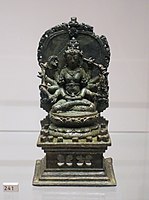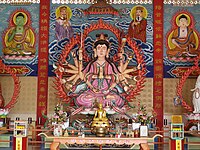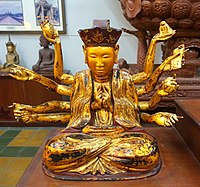Cundi (Buddhism)
| Cundī | |
|---|---|
 Painting of Cundi, China, Ming Dynasty (1368-1644). Hanging scroll, gold ink and colors on paper, 126.7 x 81.1 cm. | |
| Sanskrit | चुन्दी (IAST: Cundī) चुण्डी (Cuṇḍī) चुन्दा (Cundā) चुन्दवज्री (Cundavajrī) सप्तकोटिबुद्धमत्ड़् (Saptakoṭibuddhamatṛ) |
| Chinese | 準提菩薩 (traditional) 准提菩萨 (simplified) (Pinyin: Zhǔntí Púsà) 準提佛母 (Zhǔntí Fómǔ) 七俱胝佛母 (Qījùzhī Fómǔ) |
| Japanese | 准胝観音 準胝観音 準提観音 (Jundei / Juntei Kannon) 准胝仏母 (Juntei / Jundei Butsumo) 七倶胝仏母 (Shichikutei Butsumo) |
| Korean | 준제보살 (RR: Junje Bosal) |
| Thai | พระจุนทีโพธิสัตว์ |
| Tibetan | སྐུལ་བྱེད་མ Wylie: skul byed ma |
| Vietnamese | Chuẩn Đề Bồ tát Phật Mẫu Chuẩn Đề |
| Information | |
| Venerated by | Mahayana, Vajrayana |
Cundī (Sanskrit: चुन्दी, IPA: [t͜ɕʊndiː]; Chinese: 準提菩薩; pinyin: Zhǔntí Púsà; Tibetan: ལྷ་མོ་སྐུལ་བྱེད་མ།, Wylie: lha mo skul byed ma, THL: lha-mo kül-jé-ma) or Cundā (चुन्दा, IPA: [t͜ɕʊndaː]), also known as Saptakoṭibuddhamatṛ (सप्तकोटिबुद्धमत्ड़्, "Goddess of the Seventy Million (saptakoṭi) [Buddhas]";[1] Chinese: 七俱胝佛母; pinyin: Qījùzhī Fómǔ), is a female bodhisattva and a manifestation of the Cundī Dhāraṇī prominently revered in East Asian Mahayana and Vajrayana Buddhism.
In Buddhist traditions
While Cundī is less well known in Tibetan Buddhism, she is revered in East Asian Buddhism. In China, she is known as Zhǔntí Púsà (Chinese: 準提菩薩, "Cundi Bodhisattva") or Zhǔntí Fómǔ (Chinese: 準提佛母, "Cundi Buddha-Mother"). She is also sometimes considered a manifestation of Guanyin and in this form she is called Zhǔntí Guānyīn (Chinese: 準提觀音, "Cundi Avalokiteśvara"). She is known as Junje Gwan-eum Bosal (준제관음보살, Hanja: 准提觀音菩薩, "Cundi Avalokiteśvara Bodhisattva") in Korean, while in Japan she is known as Jundei Kannon (准胝観音, "Cundi Avalokiteśvara").
Robert Gimello observed that in China, the esoteric Tangmi practices of Cundī were extremely popular among both the populace and the elite. The Tantric goddess Cundi was the object of popular occult practice in Chinese Buddhism from the Tang dynasty and continued afterwards with the adoption of esoteric teachings by other sects of Buddhism in China.[2] In modern Chinese Buddhism, she is one of the more popular manifestations of Guanyin. She is also sometimes identified with Marīci or the Queen of Heaven.[3] In Chinese Buddhist temples in Southeast Asia, statues of Cundī are traditionally enshrined in vegetarian halls (齋堂; zhaitang).[4]
Source texts
In Hindu texts, she was considered a vindictive form of the goddess Durgā, or Pārvatī, wife of the god Śiva, before being syncretized into Buddhism.[5]
The first textual source of Cundī and the Cundī Dhāraṇī is the Kāraṇḍavyūhasūtra, a sūtra centered around the bodhisattva Avalokiteśvara that introduced the popular mantra oṃ maṇipadme hūṃ.[6] This text is first dated to around the late 4th century CE to the early 5th century CE.[7] Cundī and the Cundī Dhāraṇī are also featured in the Cundī Dhāraṇī Sūtra, which was translated three times from Sanskrit into Chinese in the late 7th century and early 8th century by the Indian esoteric masters Divākara (685 CE), Vajrabodhi (723 CE), and Amoghavajra (8th century).[6]
Cundī Dhāraṇī
According to the Cundī Dhāraṇī Sūtra, the dhāraṇī associated with Cundī is the following:[8]
- namaḥ saptānāṃ samyaksaṃbuddha koṭīnāṃ tadyathā
- oṃ cale cule cundī svāhā
In the sūtra, the Buddha speaks extensively about the various effects and benefits of reciting the Cundī dhāraṇī. Many of the effects are purifying and uplifting in nature. For example, after pronouncing the dhāraṇī, the Buddha then says:[8]

If there are bhikṣus, bhikṣuṇīs, upāsakas, or upāsikās who memorize and recite this dhāraṇī 800,000 times, their deadly karma in every place, created over innumerable eons, will be completely annihilated. In every place where they are born or reside, they will always meet Buddhas and bodhisattvas. They will always have adequate resources and abilities to do as they wish. In any birth, they will always be able to leave the home life, and will have the ability to maintain the pure precepts of a bodhisattva. They will be born in human or heavenly realms, they will not fall into evil destinies, and they will always be protected by all the heavenly guardians.
The dhāraṇī is also closely associated with buddhahood and complete enlightenment (Skt. Anuttarā Samyaksaṃbodhi). At the end of the sūtra, the Buddha closes the teaching by saying:[8]
This great dhāraṇī of Cundī is a great brilliant mantra teaching that is spoken by all Buddhas of the past, all Buddhas of the future, and all Buddhas of the present time. I also now speak it thusly to benefit all sentient beings, causing them to attain Anuttarā Samyaksaṃbodhi. If there are sentient beings with little merit, who lack the roots of goodness, natural ability, and the Factors of Bodhi, if they obtain hearing of this dhāraṇī method, they will quickly realize the attainment of Anuttarā Samyaksaṃbodhi. If there are people who are always able to remember, recite, and maintain this dhāraṇī, they will all obtain immeasurable roots of goodness.
It is widely held that the dhāraṇī can bring about many benefits, even for lay practitioners. Some of the dhāraṇī's functions include praying for success in career; harmony in marriage and relationships; and academic achievements. It is particularly helpful for young adults looking for a job, a partner in life or hoping to be successful academically. However, the wishes you make must be reasonable and legitimate. Generally, a practitioner can recite the dhāraṇī 21, 27 or 49 times per day.[9]
Iconography
Cundī is depicted with eighteen arms, each wielding implements that symbolize upaya. Her eighteen arms also represent the eighteen merits of attaining Buddhahood as described in an appendix to the Cundī Dhāraṇī Sūtra.
Gallery
Four-armed statue of Chunda, Central Java, Vanasava, Dieng Plateau, 9th-10th century AD, bronze.
Ten-armed Tantric Goddess (perhaps Chunda), Central Java, Prambanan, 10th century AD, bronze.
Painting of the Bodhisattva Guanyin in the Form of the Buddha-Mother (Cundi). By Chen Hongshou (1599-1652). Dated 1620, Ming dynasty.
Cundi, flanked by devas, and with Bhaisajyaguru Buddha (left) and Amitabha Buddha (right). The Chinese text on the front of the altar reads, Namo Zhunti Wang Pusa, or "Namo Cundi King Bodhisattva." Statue located at a Chinese Buddhist temple in Kelantan, Malaysia.
Statue of Cundi in Shishuang Temple, Jingang, Liuyang, Hunan, China.
Pair of bronze mirrors showing Cundi, one with a Sanskrit inscription in Lantsa script, and one with a Sanskrit inscription in Chinese script. Yuan dynasty (1271–1368). Held at the Capital Museum, Beijing. Similar instruments are still widely used in esoteric practices where practitioners will chant the Cundi dhāraṇī while looking into the smooth side of the mirror. From the practitioner's visual perspective, it would appear as though the deity were facing them from within the reflective surface.[10]
Statue of Cundi, Vietnam, 19th century AD, lacquered wood - held at the Museum of Vietnamese History, Ho Chi Minh City.
See also
References
- ^ Buswell, Robert E.; Lopez, Donald S., eds. (24 November 2013). The Princeton Dictionary of Buddhism. NJ: Princeton University Press. p. 204. ISBN 978-0-691-15786-3.
- ^ Gimello, Robert (2004). ″Icon and Incantation: The Goddess Zhunti and the Role of Images in the Occult Buddhism of China." In Images in Asian Religions: Texts and Contexts ed. Phyllis Granoff and Koichi Shinohara: pp. 71-85.
- ^ A dictionary of Chinese Buddhist terms : with Sanskrit and English equivalents and a Sanskrit-Pali index. Lewis Hodous, William Edward Soothill. London: RoutledgeCurzon. 2004. ISBN 0-203-64186-8. OCLC 275253538.
{{cite book}}: CS1 maint: others (link) - ^ author., Ying, Ruo Show. Chinese Buddhist vegetarian halls (zhaitang) in Southeast Asia : their origins and historical implications. OCLC 1086162650.
{{cite book}}:|last=has generic name (help) - ^ A dictionary of Chinese Buddhist terms : with Sanskrit and English equivalents and a Sanskrit-Pali index. Lewis Hodous, William Edward Soothill. London: RoutledgeCurzon. 2004. ISBN 0-203-64186-8. OCLC 275253538.
{{cite book}}: CS1 maint: others (link) - ^ a b Studholme, Alexander (2002) The origins of Oṃ maṇipadme hūṃ: a study of the Kāraṇḍavyūha sūtra: p. 175
- ^ Studholme, Alexander (2002) The origins of Oṃ maṇipadme hūṃ: a study of the Kāraṇḍavyūha sūtra: p. 17
- ^ a b c The Cundī Dhāraṇī Sūtra
- ^ Lu, Jun Hong (2018). Buddhism : your questions answered : frequently asked questions about practising Buddhism (First ed.). Sydney NSW: Guan Yin Tang Culture Centre. ISBN 978-0-9872230-5-0. OCLC 1047728511.
- ^ "Lot 129 - A CHINESE EMBROIDERED SILK 'CUNDI". www.chiswickauctions.co.uk. Retrieved 2022-01-30.
External links
- CS1 maint: others
- CS1 errors: generic name
- Articles with short description
- Short description with empty Wikidata description
- Articles containing traditional Chinese-language text
- Articles containing Standard Tibetan-language text
- Articles containing Chinese-language text
- Bodhisattvas
- Avalokiteśvara
- Buddhism in China
- Yidams
- Chinese gods
- Investiture of the Gods characters






![Pair of bronze mirrors showing Cundi, one with a Sanskrit inscription in Lantsa script, and one with a Sanskrit inscription in Chinese script. Yuan dynasty (1271–1368). Held at the Capital Museum, Beijing. Similar instruments are still widely used in esoteric practices where practitioners will chant the Cundi dhāraṇī while looking into the smooth side of the mirror. From the practitioner's visual perspective, it would appear as though the deity were facing them from within the reflective surface.[10]](https://upload.wikimedia.org/wikipedia/commons/thumb/0/0e/Bronze_Cundi-Avalokitesvara_mirror.jpg/200px-Bronze_Cundi-Avalokitesvara_mirror.jpg)

